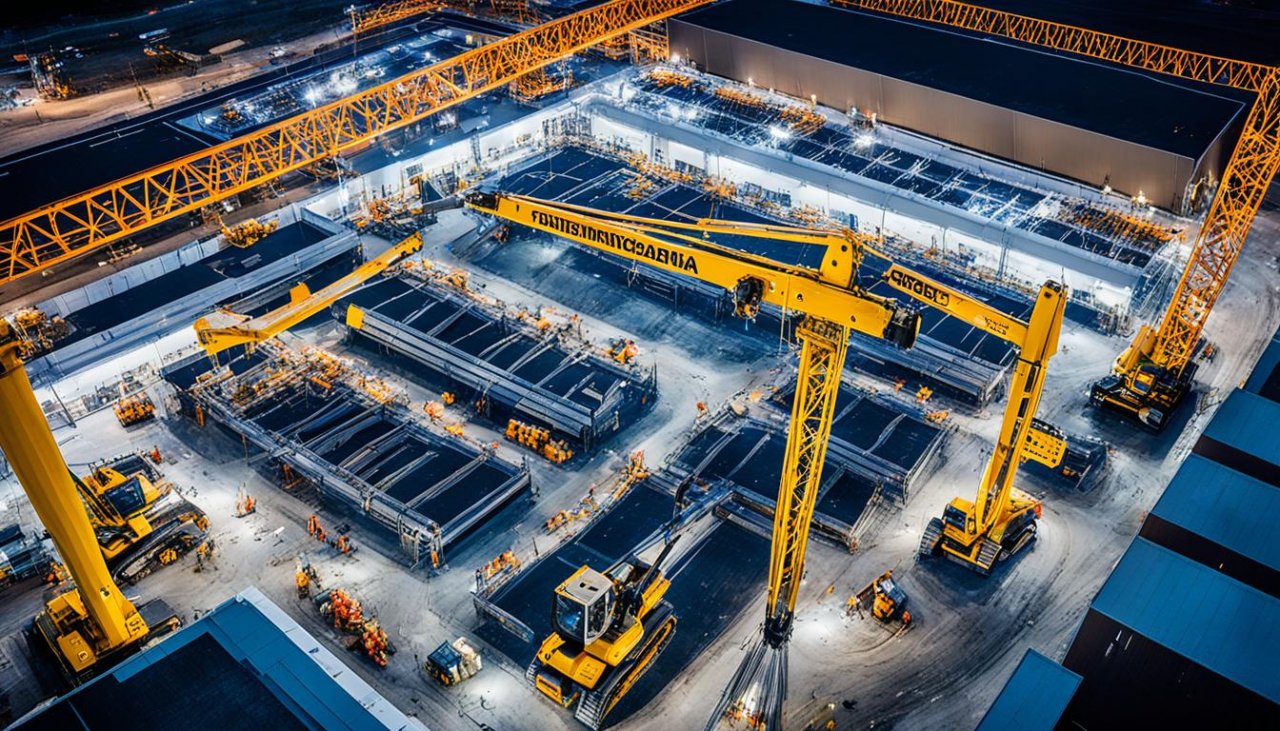What if I told you that the success of large-scale electrical projects depends on more than just technical skills? It also requires strategic planning and working well with others. Managing these projects is complex, involving many challenges.
From dealing with tough rules to working together with different teams, good management is key. As the world needs more electricity and moves towards green energy, learning to lead these projects is more important than ever.

Key Takeaways
- The electricity sector contributes to 25% of total anthropogenic greenhouse gas emissions.
- Approximately 770 million people globally still lack access to electricity.
- Utility-scale solar projects are crucial in reducing greenhouse gas emissions.
- A shift toward renewable energy sources like wind and solar is gaining traction around the world.
- Successful management of large-scale projects can stimulate economic growth by creating jobs.
- Effective electrical project management is vital to meet both environmental and economic goals.
Understanding the Scope of Large-Scale Electrical Projects
Large-scale electrical projects are complex and need careful planning. They cover everything from designing power plants to setting up big transmission systems. It’s important to understand the scale to manage resources and timelines well.
Budgets are key in deciding if a large electrical project can go ahead. For instance, making a carbon emissions-free grid could cost hundreds of billions to over $1 trillion. It’s also crucial to think about how the project will affect local communities and the environment.
Skilled professionals are vital in commercial electric engineering. By 2026, electrical engineering jobs are expected to grow by 9%. This means around 16,200 new jobs will open up, making the workforce stronger. After working in the field for ten years, electrical engineers can earn between $97,000 and $106,000. This shows how important expertise is in these big projects.
The Importance of Effective Electrical Project Management
Managing electrical projects is key to success. It involves planning, executing, and maintaining each phase with the right skills. This approach boosts efficiency, keeps costs down, and pleases stakeholders. Knowing how to manage each phase is crucial for success.
Clear communication is vital in managing infrastructure projects. It helps avoid misunderstandings and encourages teamwork. This builds trust and helps solve problems early. Tools like Microsoft Project help with planning and resource management.
Risk assessment and planning for problems prevent delays. By thinking ahead, I can save time and resources. Technologies like Building Information Modeling (BIM) help spot issues early, reducing costly mistakes.
Handling the project lifecycle’s challenges helps me balance the Project Management Triangle. I look at scope, time, and cost to make smart decisions. This approach ensures projects meet client needs and industry standards.
Key Phases in Large-Scale Electrical Projects
Managing big electrical projects means knowing the main steps. These include planning/design, pre-construction, procurement, construction, and post-construction. Each phase is crucial for the project’s success.
The planning phase is where it all starts. It involves programming, studying feasibility, designing schematics, and making contract documents. Good communication here prevents problems later on. It’s important to understand what’s needed and the possible hurdles.
Next, the pre-construction phase gets permits and deals with legal stuff. It also follows building codes. Using scheduling software helps keep things running smoothly and fixes issues early.
In procurement, managing money and avoiding miscommunication is tough. Construction project management software helps with buying things and makes things clear. This leads to better use of resources.
Construction is where the project comes to life. Good planning and talking to each other are key to keeping things moving. Problems can come from bad schedules or not talking well. Special software helps manage the site, keep quality high, and stay on schedule.
Finally, the post-construction phase finishes the project. It makes sure everything works right and meets standards. This includes inspections, final tweaks, and solving any construction problems.
Planning and Design Considerations for Electrical Infrastructure Development
When starting big electrical projects, planning is key. I look at potential sites to make sure they meet all the rules and fit the project needs. High-voltage electrical systems are vital for reliable energy. They make sure power reaches where it’s needed.
Local rules are important for renewable energy projects. Developers must work with local authorities to find the right spots for wind and solar setups. Talking with the community early helps build trust and makes the project smoother.

For high-voltage systems, checking land availability is crucial. Local zoning laws can affect where solar and wind projects can go. Working with trusted groups like universities helps during planning. I follow guidelines for placing renewable energy projects right, considering wind and solar needs.
The U.S. wants to cut carbon emissions to zero by 2050. This means more solar farms and other green infrastructure are needed. I make sure my projects are up to date with climate challenges. This helps speed up approvals and makes projects work better.
Choosing the Right Electrical Engineering Firms
Finding the right electrical engineering firm is key to a project’s success. I look at their experience in commercial electric engineering when making a choice. Their past work shows what they can do and their focus on MEP design. MEP designs help save costs and make buildings more energy efficient.
Good project execution needs strong teamwork among all involved. I check how well firms work with architects and contractors. Their history shows if they can offer custom solutions for projects. Firms that focus on sustainable and energy-efficient designs save money and help the environment over time.
Looking at a firm’s portfolio helps me see their performance and how they meet client needs. Talking to past clients gives me insights into their satisfaction. The size of projects a firm takes on shows their financial health and stability in the industry.
Compliance and Local Regulations in Industrial Electrical Installation
In the world of industrial electrical work, following local rules is key. Not following these rules can lead to big problems like injuries, legal trouble, and work stoppages. The National Electrical Code (NEC) sets the minimum safety standards for electrical work, covering everything from wiring to grounding.
Local rules can change a lot depending on where the project is. So, I always check with local authorities to see what extra rules might apply. This way, I make sure my work is safe and meets the local rules.
Inspections are very important to check if electrical work meets the rules. I keep detailed records of everything, including inspection reports and permits. Keeping good records helps me stay in line with the rules and avoids fines or other problems.
The International Building Code (IBC) stresses the need for strong safety standards in industrial places. It talks about things like fire safety and building strength. I make sure to include these in my work. Following OSHA rules is also key, especially in places like chemical plants. Knowing these rules helps me work responsibly.
By focusing on following the rules and local laws, I make sure my projects are safe and successful. It’s important to stick to the legal standards to build a trustworthy electrical system that’s safe for everyone.
Managing Power Distribution Systems Effectively
Managing power distribution systems well is key to success. It makes sure the electrical infrastructure runs smoothly. This leads to better energy reliability. Keeping an eye on how things perform is crucial. It helps spot problems early, before they get worse.
Using advanced tools helps a lot in watching over energy resources. The National Renewable Energy Laboratory (NREL) is an expert in making the grid better. They work on things like solar power and storage.
They teamed up with Pacific Northwest National Laboratory to make a free tool for managing power systems. This shows how new ideas can make things run better for power companies.
Holy Cross Energy is working with NREL on projects that use less energy. They’re making power systems more efficient. Xcel Energy is also using new tools to save money by managing power better. These examples show how good management leads to better energy use.
Collaborating with Stakeholders in Electrical Project Management
Effective electrical project management needs good teamwork with stakeholders. Talking with the community and local authorities helps make a project work better and get more support. When I focus on community engagement, I can solve problems early and get the community on board.
Engaging the Community
Getting the community involved is key in electrical projects. By building strong ties with locals, I get important feedback that shapes the project. This way, we can tackle concerns early and build trust and openness during the project.
Working closely with the community creates a true partnership. This partnership can improve the project’s success.
Working with Local Authorities
Teaming up with local authorities makes dealing with rules easier. Keeping in touch with them ensures we follow the right rules and avoid delays. With local government support, we can spot and solve problems early, making the project run smoother.
This teamwork makes managing the project more efficient and successful.

Utilizing Technology in Electrical Design and Construction
Exploring electrical design and construction shows how technology has changed our approach. Tools like computer-aided drafting (CAD) and Building Information Modeling (BIM) are key. They help with planning and make sure everything goes smoothly.
At Ranken Technical College, they teach the value of these tools in their Electrical Systems Design Technology program. Students learn to design and build electrical systems. They get ready for jobs in electrical fields, becoming junior electrical designers or estimators.
Software like ElectricalOM makes designing easier. It helps follow rules like BS 7671 and makes designs better. Its easy interface and calculation engine make changing designs and figuring out cable sizes quick and accurate.
With more energy use and new tech in energy distribution, using modern tools is a must. This move to smart technologies makes electrical systems more reliable and efficient. It opens doors for sustainable energy solutions in the future.
Risk Management Strategies for Large-Scale Projects
Managing big electrical projects has its own set of challenges. One effective way to tackle these is through risk management strategies. These strategies help me spot and look into risks early on. They cover everything from supply chain delays to sudden changes in laws.
Not managing risks can lead to big problems like going over budget and delays. Knowing the risks my industry and company face helps me make plans for them. Having strong contingency plans also makes me ready for surprises.
A good risk management plan includes steps like identifying, sorting, and keeping an eye on risks. Tools like risk registers track risks, strategies to fix them, and who’s in charge. Techniques like risk matrices are key in figuring out and tackling risks.
Having a diverse team throughout the project helps with risk management. This way, we can tackle problems at the planning and operation stages. Using methods like Failure Mode and Effects Analysis (FMEA) helps spot potential failures early. Scenario planning gets us ready for the unexpected.
It’s crucial to know the main risks in big projects, like financial, environmental, and legal ones. By always checking and managing these risks, we can keep projects on track and reach our goals. This focus on risk management boosts team performance and sets the stage for long-term success.
The Role of a Strategic Distribution Manager
A Strategic Distribution Manager is key in managing big electrical projects. They connect clients with utility services, making sure projects run smoothly. They handle many challenges and keep everyone talking well.
At SRP, these managers have lots of experience. People like Tony Alvarado have spent years learning about energy management. They bring their deep knowledge to the table, helping projects succeed.
For instance, Chandra Mergan knows a lot about building new substations. Chelsea Clark understands how to design and build distribution systems. They make sure projects meet client needs on time.
These managers don’t just lead projects. They also talk about how to make energy use better. Doug Gooch and Nolan Jeffries work on making power reliable for homes and businesses. Their work shows how important Strategic Distribution Managers are in the electric industry.
In short, Strategic Distribution Managers are crucial for big electrical projects. They connect people, talk things through, and manage energy use. This helps projects go well.
Conclusion
Managing big electrical projects well means knowing how to plan, work with stakeholders, and follow the rules. This article has shown us key strategies for doing this. We’ve looked at how to pick the right engineering firms and use the latest technology. These steps are crucial for projects to succeed and use new energy solutions.
As we move to using more wind and solar power, we must think about the environment. The strategies we’ve talked about help us deal with issues like land use and climate change. They show how important it is to manage risks well. By using these methods, we can get better results and meet energy needs in a green way.
In the end, winning at big electrical projects takes careful management of every detail. We need to keep improving and finding new ways to do things. This ensures we meet energy needs now and prepare for the future. The path to success is always changing, but with the right approach, we can handle what comes next.
See how FieldAx can transform your Field Operations.
Try it today! Book Demo
You are one click away from your customized FieldAx Demo!
FAQ
What are large-scale electrical projects?
Large-scale electrical projects are about building big electrical systems. This includes power lines and high-voltage systems. They need a lot of planning and a team to work together well. Following rules is also key to success.
Why is effective project management important in electrical projects?
Good project management is key because it guides a project from start to finish. It makes things run smoothly, saves money, and keeps everyone happy. This leads to projects that do well.
What are the key phases of managing large-scale electrical projects?
The main steps are planning, designing, building, and finishing up. Each step is important to make sure the project meets needs and is safe. It also helps avoid problems and keep everyone responsible.
How do I choose the right electrical engineering firm?
To pick the right firm, look at their skills in commercial electric work and their past successes. Check how good their team is. A strong partnership can make the project go better and smoother.
What compliance requirements should be considered in industrial electrical installations?
Following local rules is crucial for industrial electrical work. This means getting the right permits and licenses. It also means making sure the project is safe and good for the environment by working with local authorities.
How can I effectively manage power distribution systems?
To manage power systems well, focus on making them reliable. Keep an eye on how they’re doing and plan for upkeep. This helps fix problems early and keeps the power flowing well.
What role does technology play in electrical design and construction?
Technology is very important by using new tools and software. These help with planning, designing, and building. They make the process more accurate and efficient, leading to better electrical projects.
What are some common risks associated with large-scale electrical projects?
Big projects often face risks like going over budget, delays, and technical problems. Spotting these risks early and having a plan can help deal with them.
What does a Strategic Distribution Manager do?
A Strategic Distribution Manager connects clients with utility services. They make sure projects meet needs. Their skills are key for overcoming challenges and talking to everyone involved.
Author Bio
Co-Founder & CMO at Merfantz Technologies Pvt Ltd | Marketing Manager for FieldAx Field Service Software | Salesforce All-Star Ranger and Community Contributor | Salesforce Content Creation for Knowledge Sharing





